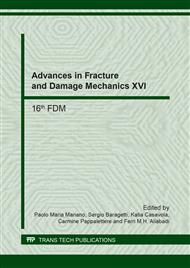p.135
p.141
p.145
p.149
p.153
p.157
p.161
p.165
p.169
A Phase Field Approach to Fracture with Mass Transport Extension for the Simulation of Environmentally-Assisted Cracking
Abstract:
The fracture mechanics assessment of materials exposed to harmful environments requires the understanding of the interaction between the soluted species and the affected mechanical behaviour. With the introduction of a mass transport mechanism the entire problem is subjected to a time frame that dictates the time-dependent action of soluted species on mechanical properties. A numerical framework within the phase field approach is presented with an embrittlement-based coupling mechanism showing the influence on crack patterns and fracture toughness. Within the phase field approach the modeling of sharp crack discontinuities is replaced by a diffusive crack model facilitating crack initiation and complex crack topologies such as curvilinear crack patterns, without the requirement of a predefined crack path. The isotropic hardening of the elasto-plastic deformation model and the local fracture criterion are affected by the species concentration. This allows for embrittlement and leads to accelerated crack propagation. An extended mass transport equation for hydrogen embrittlement, accounting for mechanical stresses and deformations, is implemented. For stabilisation purposes a staggered scheme is applied to solve the system of partial differential equations. The simulation of showcases demonstrates crack initiation and crack propagation aiming for the determination of stress-intensity factors and crack-resistance curves.
Info:
Periodical:
Pages:
153-156
Citation:
Online since:
September 2017
Authors:
Price:
Сopyright:
© 2017 Trans Tech Publications Ltd. All Rights Reserved
Share:
Citation:


